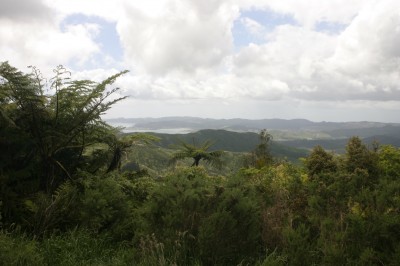Huge ferns and fern trees, kauri trees, palm trees and trees to me unknown that look like they have an ancient genetic history fill this primordial forest. It is reminiscent of illustrations showing what the world looked like when the continents were joined in Gondwana, when dinosaurs wandered the earth, before the Ice Age did it off with them, and before we humans came and mucked everything up.
Verdant, lush, mysterious. Epiphytes attach themselves to the trees like botanical penthouse apartments, providing living space for tiny insects and other organisms. Everyone strives for the top, reaching for the light. It is like walking through a rain forest but without the mugginess, the snakes, the leeches, and the creepy crawlies. This is the Coromandel Peninsula on the east side of New Zealand’s North Island.
We walk through an area containing New Zealand’s few remaining kauri trees, called Kauri Grove. The kauri are ancient, slow-growing trees. The wood is very durable making it a sought after product for timber. That was almost it’s demise but just before loggers rendered it extinct, environmentalists stepped in and now the precious kauri tree is conserved. They grow tall (up to 50 m), wide (3 m in diameter) and old (several thousand years). A great tree for a nice big hug.
At every twist and turn (and there are a lot of those!) the hilly and sometimes mountainous landscape is lush and green. When not covered with forest, the land is covered by a velvety green carpet of grass, and huge herds of dairy cows and sheep and beefy cattle graze the slopes (and burp and fart lots of greenhouse gases). The plants in people’s gardens merge with the wild plants and it is sometimes hard to see where the man-made stops and nature takes over. It must be a dream to be a gardener here.
Occasionally all of this incredible greenness is broken by clear-cut areas, where the forest has been shaved away, leaving just the bare slopes and something that looks like an ecological disaster area. It looks like forests are replanted here and there but just with a monotony of pine trees. Such a shame.









